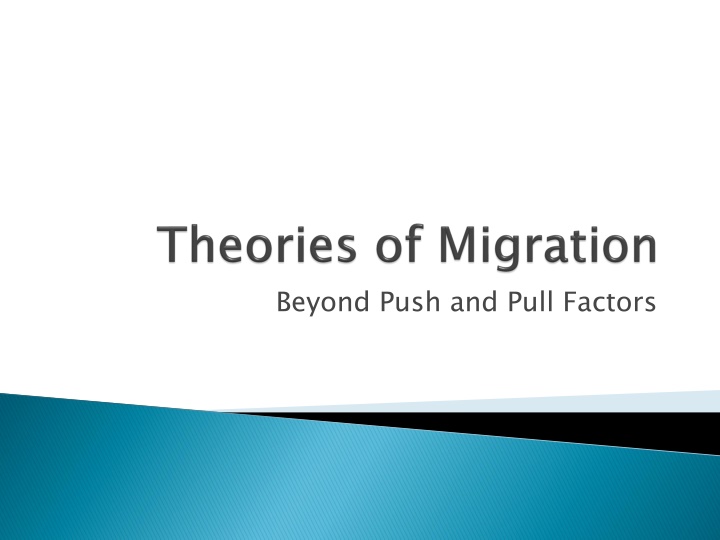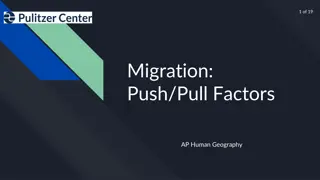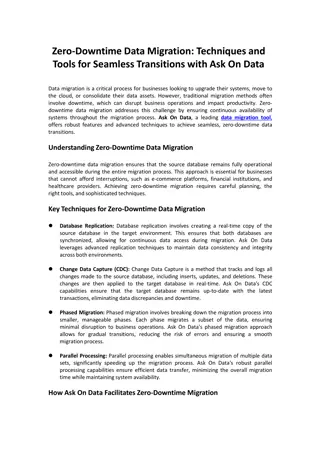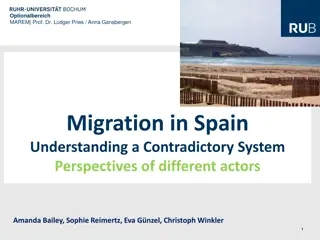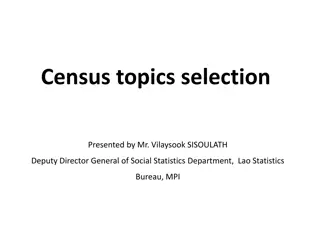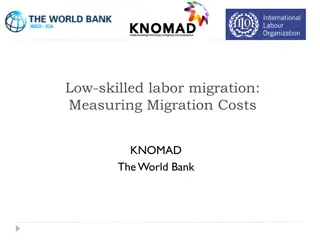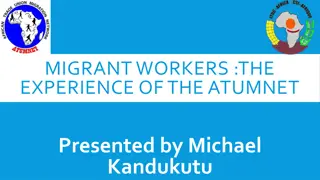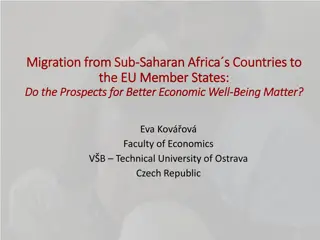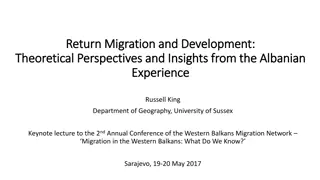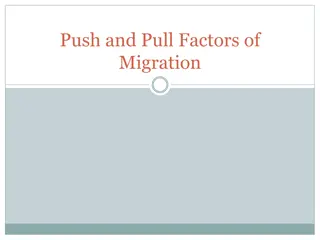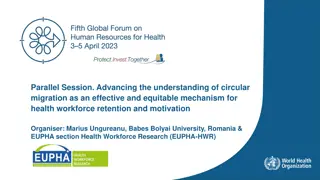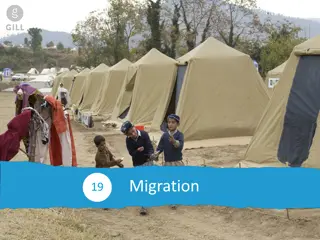Economic Migration Factors
Migrants make rational decisions based on wage rates, job security, and travel costs, using a human capital approach. International migration is driven by earnings differentials and employment conditions, with families collectively maximizing income and minimizing risks. Remittances from migrant workers support households facing local economic challenges, especially in developing countries lacking risk management mechanisms.
Download Presentation

Please find below an Image/Link to download the presentation.
The content on the website is provided AS IS for your information and personal use only. It may not be sold, licensed, or shared on other websites without obtaining consent from the author.If you encounter any issues during the download, it is possible that the publisher has removed the file from their server.
You are allowed to download the files provided on this website for personal or commercial use, subject to the condition that they are used lawfully. All files are the property of their respective owners.
The content on the website is provided AS IS for your information and personal use only. It may not be sold, licensed, or shared on other websites without obtaining consent from the author.
E N D
Presentation Transcript
Each migrant rational human being choosing optimum combination of wage rates, job security, and costs of travel (human capital approach series of investments in education, skills, material cost of traveling, maintenance while looking for work, learning new language/culture, difficulty in experiencing new labor market, psychological costs cutting old ties, marginal analysis, weighing costs and rewards).
Differentials on wages and employment conditions between countries and on migrant costs, individual decision to maximize income. International movement does not occur in absence of differences in earnings/and or employment rates between states. Migration occurs until expected earnings have been equalized internationally.
Demand of Western European countries for foreign migrant workers; if what counted were wage differentials, then poorest would want to move first, evidence from around world doesn t support this;
New Economic of Migration decisions are not made by isolated individuals but by larger units of related people-typically families or households, people act collectively to maximize expected income, and minimize risks and loosen constraints associated with variety of market failures, apart from those in the labor market. New Economic of Migration- - migration
While some families can be assigned economic activities in the local economy, others may be sent to work in foreign labor markets where wages and employment conditions are negatively/weakly correlated with those in the local area. In event that local conditions deteriorate, household can rely on migrant remittances for support.
In developed states, risks to household income are generally minimized through private insurance markets or government programs, but in developing states institutional mechanisms for managing risk are imperfect, absent, or inaccessible to poor families, giving them incentives to diversify risks through migration.
New economic theorists argue that households send workers abroad not to improve income in absolute terms, but also to increase income relative to other households, and reduce deprivation compared with some reference group. Market failures that constrain local income opportunities for poor households may also increase the attractiveness of migration as an avenue for effecting gains in relative income.
Assumptions of new economic theory- wage differentials IM to occur, households may have strong incentives to diversity risks transnational movement even in the absence of wage differentials. For example, if a poor s family incomes stays the same as another families rises, they will experience greater relative deprivation wage differentials is not a necessary condition for diversity risks through relative deprivation.
Intl Migration and local employment/production are not mutually exclusive possibilities, there are strong incentives for households to engage in both migration and local activities returns to local economic activities may heighten the attractiveness of migration as a means of overcoming capital and risk constraints on investing in those activities. strong incentives for households to engage in both migration and local activities, an increase in
Conclusion to do with wage rates or employment differentials between states; it follows from the dynamics of market creation and the structure of the global economy. International migration not linked to bifurcation of the labor market within particular national economies, but to the structure of the world market that has developed since the [long] sixteenth century. Conclusion: International migration has little to do with wage rates or employment differentials between states; it follows from the dynamics of market creation and the structure of the global economy. : International migration has little
Driven by higher profits and greater wealth owners and managers enter poor countries in search of land, raw materials, labor, and new consumer markets. In the past, market penetration was assisted by colonial regimes that administered poor regions for the benefit of economic interests in colonizing societies. Labor within peripheral regions come under the influence and control of markets, migration flows are inevitably generated. higher profits and greater wealth
Land undermines traditional social and economic relations based on subsistence. And the use of modern inputs(e.g. fertilizers, pesticides) produce high crop yields at low unit prices, driving small, non-capitalist farmers out of local markets. These forces help to create a mobile labor force displaced from the land with a weakened attached to local agrarian communities. Raw materials former peasants undermines traditional forms of social and economic org based on systems of reciprocity and fixed role relations and creates incipient labor markets based on new conceptions of individualism, private gain, and social change, promoting geographic mobility of labor. Land- the substitution of cash crops for staples These forces help to create a mobile labor force displaced from the land with a weakened attached to local agrarian communities. Raw materials- The offer of wages to
Labor- firms from intl states establish assembly plants that take advantage of low wage rates, within special export-processing zones created by sympathetic governments. Demand for factory workers strengthens local labor markets while deteriorating traditional productive relations. Feminization of workplace limits opportunities for men. Foreign owned factories undermine peasant economy by producing goods that compete with locally made goods, feminizing the workplace,
Women are socialized for industrial work and modern consumption but without being able to generate income capable of meeting those needs. The result is the creation of a population that is socially and economically uprooted and prone to migration. Some migrate to the cities, others are drawn abroad since globalization creates material and ideological links to the place where capital originates. Some migrate to the cities, others are drawn abroad since globalization creates material and ideological links to the place where capital originates.
Material Links globalization are accompanied by the build-up of a transportation and communication infrastructure, the IM of labor generally follows the international movement of goods and capital Ideological links and Pakistanis learn English, take British-style degrees; or w/out colonial past the influence of economic penetration, Mexicans studying at U.S. universities speak English, and follow American consumer styles, reinforced by mass communication , TV programming; Material Links- - Because investment and Ideological links- - Ties with colonial past, Indians
Global cities finance, administration, professional services, and high-tech production are concentrated. In the United States, global cities include NY, Chicago, LA, and Miami. In Europe they include London, Paris, Frankfurt, and Milan. Within these global cities, a great deal of wealth and a highly educated workforce are concentrated and strong demand for unskilled labor(busboys, gardeners, waiters, hotel workers, domestic servants) Global cities- - Urban centers in which banking,
At same time, shifting of heavy industrial production overseas; the growth of high tech manufacturing in electronics, computers, and telecommunications; expansion of service sectors like health and education create a bifurcated labor market, with strong demands at the upper and lower ends but not in the middle; IM is a natural consequence of capitalist market formation in the developing world; the penetration of the global economy into peripheral regions is the catalyst for international movement
